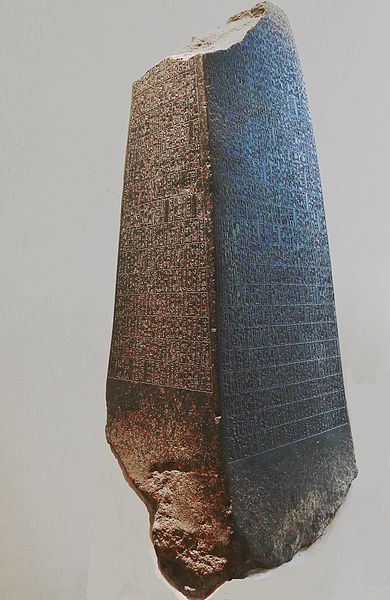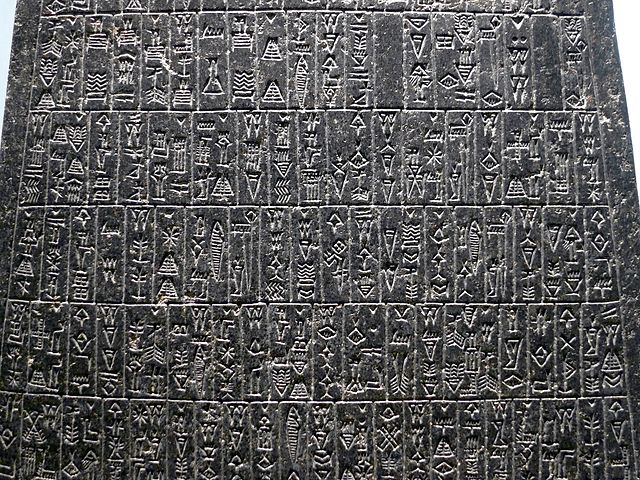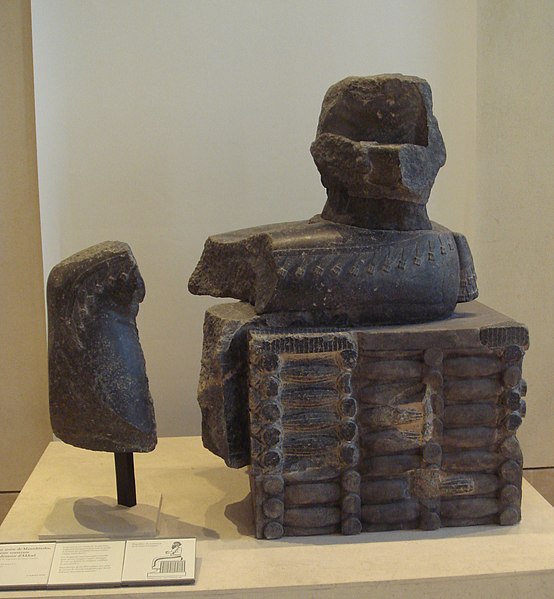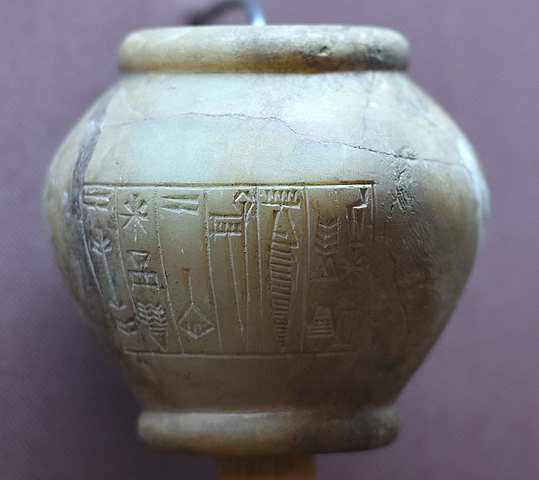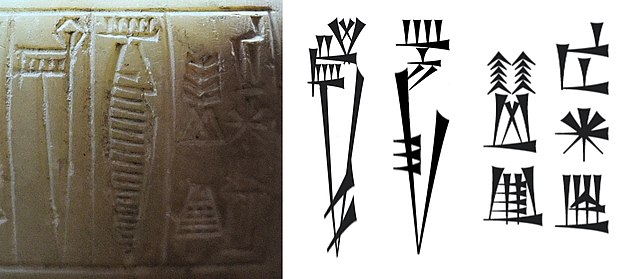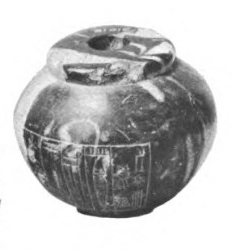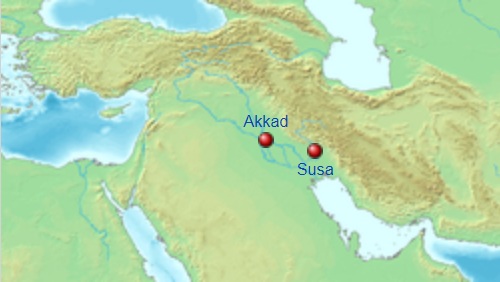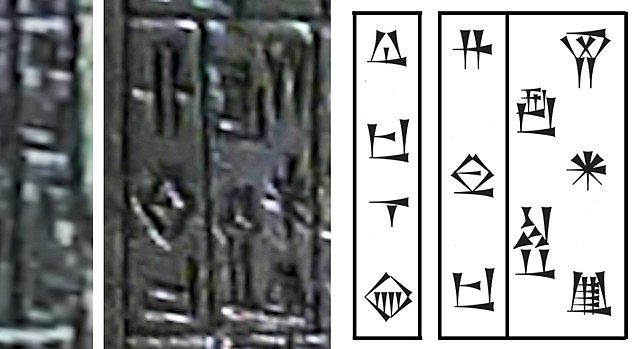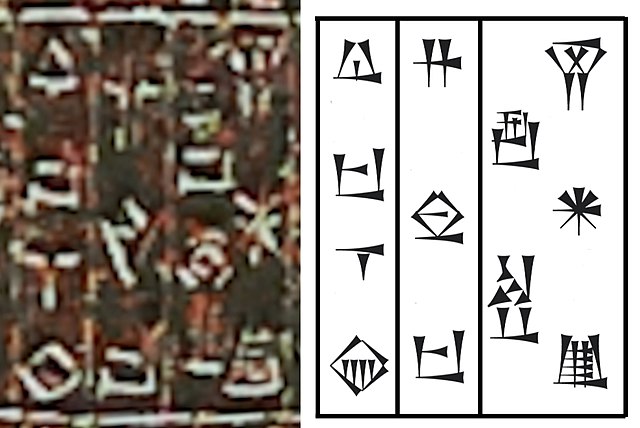
| MENES / MANISHTUSHU
Statue of Manishtusu. The inscription on the robe is in Elamite, added in the 12th century BCE. According to it, the statue was taken from Akkad and brought to Susa in the 12th century BCE by king Shutruk-Nakhunte. Louvre Museum.
Menes / Manis-Tusu / Manishtushu (Ma-an-ish-tu-su) was the third king of the Akkadian Empire, reigning from c. 2270 BC until his assassination in 2255 BC (Middle Chronology). He was the son of Sargon the Great, the founder of the Akkadian Empire, and he was succeeded by his son, Naram-Sin.
Biography
:
He became king in c. 2270 BC after the death of his brother Rimush. Manishtushu, freed of the rebellions of his brother's reign, led campaigns to distant lands. According to a passage from one of his inscriptions, he led a fleet down the Persian Gulf where 32 kings allied to fight him. Manishtushu was victorious and consequently looted their cities and silver mines, along with other expeditions to kingdoms along the Persian Gulf. He also sailed a fleet down the Tigris River that eventually traded with 37 other nations, conquered the city of Shirasum in Elam, and rebuilt the destroyed temple of Inanna in Nineveh in c. 2260 BC. In Elam and Pashime, in the coastal area of Iran, Manishtushu had governors installed for the Akkadian Empire: Eshpum was in charge of Elam, while Ilshu-rabi was in charge of Pashime.
In c. 2255 BC Manishtushu died, assassinated by members of his own court, and was succeeded by his son Naram-Sin. A pyramidal stele erected by Manishtushu bearing a long cuneiform inscription in Akkadian is featured in the Louvre.
He held the title "King of Kish" in some of his inscriptions.
Manishtushu trampling enemies :
Remain of the statue
Enemy being trampled
Enemy being trampled Other artifacts :
Manishtushu Obelisk, Louvre Museum
Detail of inscription on the obelisk
Throne of Manishtushu, Louvre Museum
Votive stone mace-head in the name of Manishtushu, from Uruk, Iraq. 2270 - 2255 BCE. Iraq Museum
Macehead inscription of Manishtushu: Manishtushu Lugal Kish, "Manishtushu King of Kish"
Macehead in the name of Manishtushu, British Museum, BM 91018 Manishtushu Obelisk :
The Manishtushu Obelisk is a diorite, four-sided stele. The stele is obelisk-shaped, as well as it narrows upward to its (damaged) top, in a pyramidal-form. The obelisk was erected by Manishtushu, son of Sargon the Great, of the Akkadian Empire, who ruled circa 2270–2255 BC.
As a spoil of war, the stele was taken to Susa by the Elamite king Shutruk-Nakhunte in the 12th century BC.
Manishtushu Obelisk, Louvre Museum
Material : Diorite
Created : 2270 - 2255 BC
Discovered : Susa
Present location : Louvre Museum, Paris
Registration : Sb 20
The Manishtushu Obelisk, created under the Akkadian Empire in Mesopotamia circa 2270 – 2255 BC, was taken as booty to Susa in the 12th century BC Description and purpose :
Manishtushu Obelisk (detail), Louvre museum The Manishtushu Obelisk is 1.4 m tall, and 0.6 m wide on its four sides. It is made of deep black diorite, and incised in Akkadian language cuneiform in horizontal rows on all sides. The cuneiform is written within 1519 boxes, as lined registers. The material was imported into Sumeria from Magan – today the area covered by the United Arab Emirates and Oman, and on clay tablets Manishtushu recorded: "From mountains beyond the 'lower sea' (Persian Gulf), he took black stones; he loaded [them] on boats and docked [them] on the quay at Akkad. He fashioned his statue [and] dedicated [it] to Enlil."
The obelisk text is a legal record that records the distribution of four parcels of land, in large estates, and its allotment to his officers, for his control of Kish.
Ilshu-rabi
:
(dumu) il-su-ra-bi2 ensi2 ba-si-me{ki}
- Manishtushu Obelisk
"Ilšu-rabi, Governor of Pashime" appears in the Manishtushu Obelisk
"Son of Ilshu-rabi the Governor / of Pashime" on the Manishtushu Obelisk (Columns 22 and 23, surface c)
"Son of Ilshu-rabi, Governor of Pashime" on the Manishtushu Obelisk (Column 15, surface d)
Source :
https://en.wikipedia.org/
https://en.wikipedia.org/ |
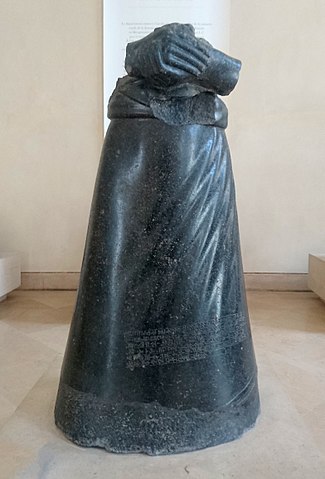
.jpg)
.jpg)
.jpg)
